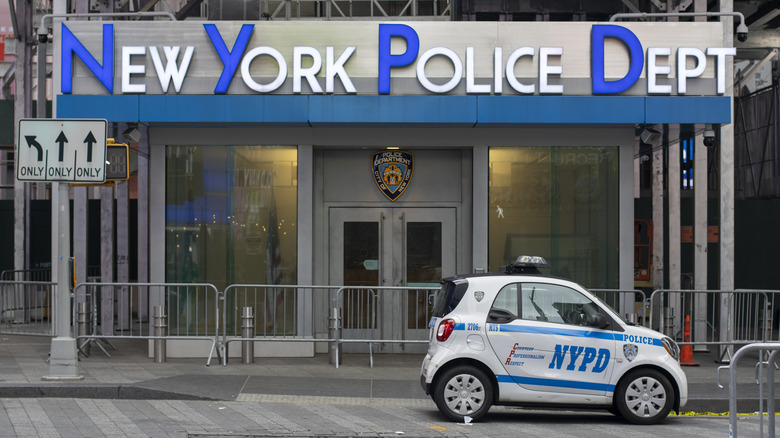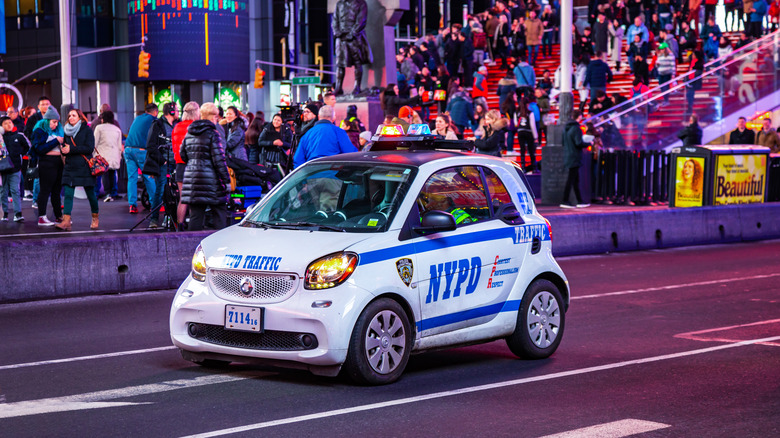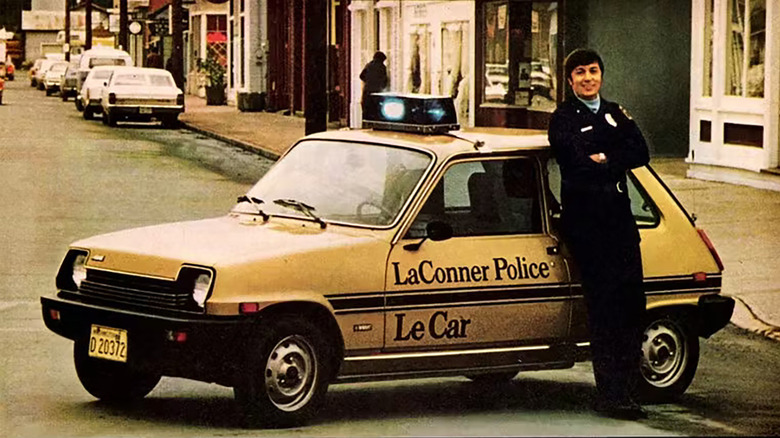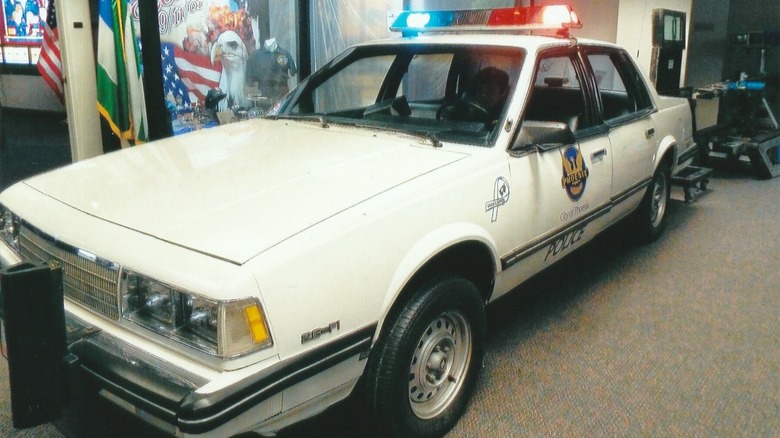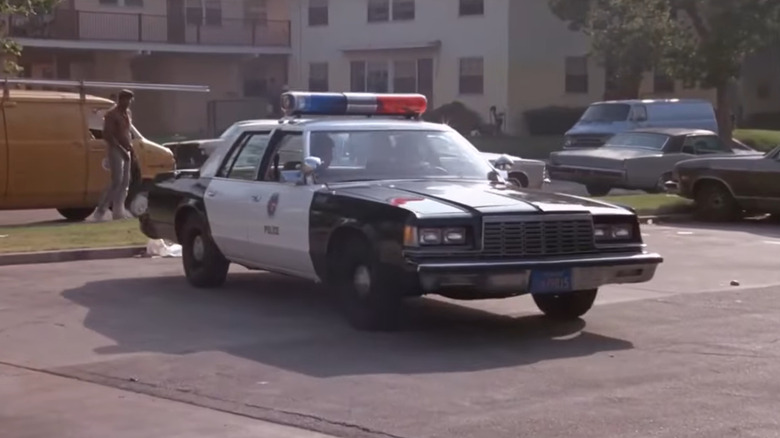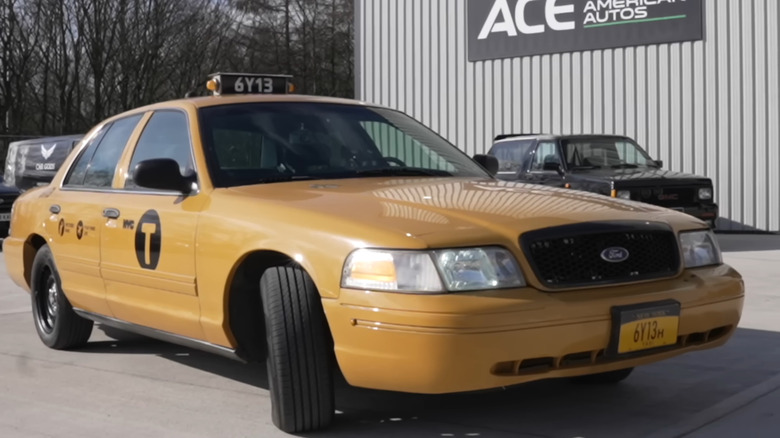5 Of The Strangest Classic Police Cars In America
Police cars have always had a special place in automotive culture. Often the protagonists in crime movies and highway chases, police cars have always attracted wonder from enthusiasts. What makes them different? Are they more powerful than the regular model? Could you ever own one?
Of course, police cars are different. To begin with, they need to be equipped with specialized equipment that allows communication with the station and other officers. Furthermore, police cars come with GPS, cameras, special lighting, computers, and other tools that help officers navigate unknown areas and fight crime. The mechanical changes are perhaps even more interesting. Cop cars often have extra bracing to protect against crashes, reinforced suspension, and specially designed engines with better cooling and larger, heavy-duty batteries. Some are built all around going faster. We've seen some incredible police cars, like Bugatti Veyrons and Dodge Challenger Hellcats.
This, of course, generates an image of an overpowered vehicle that nobody can escape from, and the truth is, that's the case with most police cars. Even so, not every cop car is tough or fast. In fact, there have been some unusual classic police cars that don't represent the typical view of American law enforcement. Some of these were functional, yes, but they can still look out of place prowling for criminals. Others should never have been chosen for law enforcement. Either way, these five strange American police cars will surely catch you by surprise!
NYPD Smart ForTwo
It's safe to say that a good police car should serve as a symbol of law enforcement authority. This makes NYPD's choice of the Smart ForTwo as a patrol car quite strange, especially in a country that loves its massive trucks and SUVs. The Smart ForTwo is truly tiny, measuring just 106.1 inches long, meaning it's shorter than the wheelbase of the Ford F-150! In fact, you can fit two Smart ForTwos in one F-150 SuperCab lengthwise and still have space left.
Okay, it's small, but what about speed? Well, the NYPD ForTwo has a turbocharged engine. Don't get too excited, though, as it's a tiny 898cc unit with just 89 hp. But it's also equipped with a five-speed manual transmission, rear-wheel drive, and an engine in the back, so police officers could have some fun behind the wheel. The 0-60 acceleration of 10.5 seconds is also far from impressive, but okay for such a small vehicle.
Crucially, each of NYPD's 250 Smart ForTwos is equipped with all the necessary police equipment. Roof-mounted rotating light and police frequency radio? Check. Airbags around both seats to protect the officers? Also check. The ForTwo police cars even have electronic stability control (ESP) and anti-lock braking systems (ABS) onboard, just in case the officers are too eager when chasing other vehicles.
Jokes aside, though, the ForTwo police cars were never meant to be police interceptors. Instead, they replaced three-wheel motorcycles in the fleet, providing much higher comfort and practicality. The micro-car's tight turning radius is also a huge advantage in parks and narrow spaces, where regular police cars don't make sense.
LaConner/Ogunquit Police Department Renault Le Car
The ForTwo isn't the first small car to serve police duty. In fact, in 1976, the LaConner, Washington police force purchased a Le Car — one of the best Renault cars sold in America. A few years later, the Ogunquit Police Department followed suit by turning to the Le Car for police duty. The small French city car joined a Volvo 240 as the second vehicle in the police department's garage.
But why? Well, the United States was experiencing a deep recession, and the Ogunquit Police Department needed a cheaper and more economical car to get by. Besides, such a car made sense for a town with fewer than 900 residents.
Interestingly, though, the department didn't just pick Renault's city car at random. A press release claimed that multiple cars were tested. In the end, the Le Car was chosen because of its "snappy performance," a consequence of its front-wheel-drive architecture and features like rack-and-pinion steering, four-wheel independent suspension, and Michelin steel-belted radial tires.
There might've been some truth in it. After all, the Le Car, sold as the R5 in Europe, is one of France's most significant vehicles. It looked quite extravagant and chic for its time, had a fairly comfortable interior for its size, and people appreciated its economical engines. As a result, it was the best-selling vehicle in France from 1972 to 1984! The car is so legendary that Renault recently launched a brand-new R5 EV, which has quickly become one of the best-selling EVs in France.
Chevrolet Celebrity 9C1
The financial crisis wasn't only hitting smaller police departments. Many departments downgraded from expensive and powerful cars to smaller vehicles, like the Chevy Malibu 9C1. Still, at least this car had all the necessary upgrades you'd expect from a police vehicle. Its body panels were made from a higher-grade steel for better crash protection. The suspension featured upgraded springs, shocks, and sway bars for better handling, further helped by the special performance tires. Oh, and let's not forget the four-barrel 350 LT1 V8.
But things got worse with the Celebrity 9C1, launched in 1984 as Chevy's new mid-size offering. Although there is no mention of the equipment, we'd imagine the Celebrity 9C1 had the police-car upgrades you'd expect, with one glaring blemish — no V8 engine. Instead, Chevy opted for the underpowered 2.8-liter V6, which just couldn't keep up with the bad guys. The fuel-injected, pushrod V6 produced only 130 hp and a lowly 145 lb-ft of torque in its high-output form. Paired to a three-speed automatic, it could only propel the Celebrity to 60 in 10.6 seconds. Yup, that's slower than NYPD's Smart ForTwo!
Chevrolet did offer a Celebrity with a four-speed manual, but only with the comically underpowered 2.5-liter four-cylinder with 92 hp. Interestingly, in a 1984 Chevrolet Celebrity review, Car and Driver praised the road manners of the sedan equipped with the Eurosport package. Still, with many roads in America being straight, this didn't help the Celebrity 9C1's fortunes in high-speed chases. As a result, the Celebrity 9C1 was decommissioned after 3 years of service.
Dodge St. Regis
Just like its biggest competitor, Chrysler was also downsizing most of its sedans during the 1970s. And we are not talking a few millimeters here and there. The brand-new R-body cars — the Dodge St. Regis, Chrysler Newport, and Plymouth Gran Fury — were 5 inches shorter and almost 1,000 pounds lighter. Even so, they were bigger than GM's and Ford's compact offerings, which didn't help sales when another gas crisis hit in 1979.
The biggest issue with these cars was the horrific quality. Of course, this was the most apparent in the Dodge St. Regis police cars, which had all sorts of issues. The interior was assembled so badly that many parts didn't fit even from the factory. Things got worse with time, with parts falling off or breaking. The St. Regis also ate tires at an alarming rate due to bad alignment.
Still, the strangest thing about the St. Regis is that despite all its shortcomings, cops liked it. The 318-cubic-inch and 360-cubic-inch engines were definitely the biggest reason, despite being detuned due to the tighter emission rules. Notably, the bigger V8 produced 195 horsepower, or 190 horsepower in emissions-strict California. It was also exclusively paired to a three-speed automatic, which was probably the bigger reason for the 0-60 sprint of 12.5 seconds. The St. Regis had good handling on its side — another reason why officers loved driving it. Let's not forget that it also starred in the "T.J. Hooker" TV series.
NYPD Undercover Disguised Taxi Cabs
Yup — the NYPD has five undercover taxi cabs in its fleet. Shocker, we know. But it makes a lot of sense. The cops can use these vehicles in covert operations because they blend so well with other taxi vehicles. Finding one in New York City's famous traffic jam can be quite a challenge.
Sure, you can spot one by looking for some indicators. Usually, these cars have the colors and markings of a taxi vehicle, but the upgrades of regular police cars. These include an additional bulletproof panel on the front door, front pusher bumper, antenna array on the trunk door, and tinted windows. You could also look up for the medallion number on NYC's website to see whether it belongs to the TLC (Taxi & Limousine Commission) database.
Still, some people claim that the older Ford Crown Victoria undercover taxi cabs were harder to spot. They still had police sirens and flashing lights, but hidden from view. Meanwhile, the current Ford Taurus models are easier to spot due to the extensive body reinforcements, but particularly because they are not very popular among taxi drivers anymore. In fact, many drivers opt for Camry Hybrids lately, thanks to the excellent mpg figures of Toyota's hybrids.
